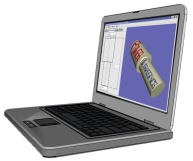A new online ultrasonics components store has just opened at www.UltrasonicsWorld.com. Check their amazing prices for replacement ultrasonics components, fully compatible with the major manufacturers' originals at a fraction of the cost.
You are here
ultrasonic separation of fine gold and black sand
Hello
I am new to this site and would like some suggestions on an idea I am working on.
I live in northern British Columbia, Canada, and my hobby is placer mining for gold. At today's gold prices, however, it is starting to be more than a hobby.
I will describe two methods for concentrating gold in black sand, how they are related, and why I need help with ultrasonics.
The first concentrator is a hopper that is oscillated laterally about 30 - 50 times per minute. It is kept saturated by water lines fed into the bottom of the hopper and -5 mm sand is fed in from the top on one side and overflows the other side. Essentially, the machione is creating sand liquefaction identical to what an earthquake will do to saturated sand. Once liquefaction is achieved, dense particles, such as fine gold particles, quickly settle to the bottom of the hopperful of sand. In this case, liquefaction is achieved by the increasing pore pressure of the water between sand particles. When the pore pressure is elevated high enough, each sand particle is isolated from the others by a jacket of water. Then, frictional resistances between sand particles is eliminated, viscosity drops to zero and liquefaction is achieved.
The second concentrator was described to me by an acquaintance on the Net. He had ground black sand to 400 mesh in a small ball mill to release hidden gold values. I assume the material was dry but I cannot confirm this. He then placed the ore in the cup of an ultrasonic jewellery cleaner and turned it on. According to him, gold particles settled to the bottom of the cup and, as more black sand was added, waste tailings overflowed the cup. He claimed to have recovered over 95% of the gold from about 100 litres of black sand this way which is very impressive at 400 mesh. He also stated that the degassing properties of the cleaner he was using made quite a difference. What is degassing?
I believe the two methods are related by the fact that liquefaction of sand is accomplished although different methods are employed. In the first, raising the pore pressure of water between particles by slow lateral oscillations liquefies the sand. In the second, I believe (though I am not sure) that ultrasonic vibrations eliminate the frictional resistance between sand particles and thus achieve liquefaction of sand without water.
While the ultrasonic separation may work well on a small unit with dry sand, I am wondering if it is practical to scale this idea up to a unit with a hopper of 20-40 litres capacity. Also, as it is not practical, at the claim site, to dry sand in large quantities, I wonder how feeding damp sand into such a machine would effect its operation. I would tend to think it may lead to compaction at the bottom of the hopper yet it may not. Your thoughts? If compaction was a problem, a water fed manifold on the bottom of the hopper, with multiple injection ports could be installed as in the first concentrator I described. It was also, as in the first concentrator, assist in helping dense particles to settle out and light particles to be carried away.
From what I can tell, there is nothing in the placer mining world that employs ultrasonic vibration, and anything developed along these lines would be cutting edge technology.
Please let me know if you think I am pursuing a practical idea.
Best regards
Bob Prud'homme

